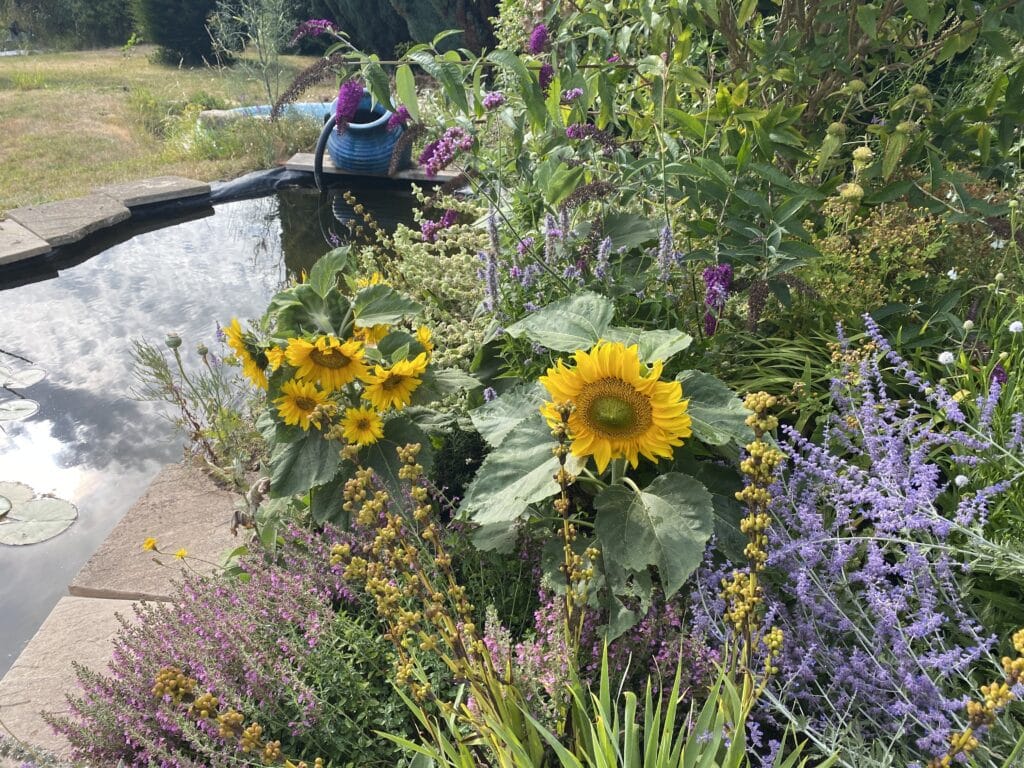Large, bright blooms and attractive green leaves can make sunflowers look appealing to dogs, so much so that they would nibble on them.
Although not very harmful, the experience can become difficult for your pets, requiring immediate intervention.
Read on to discover what sunflower parts cause poisoning, symptoms, and appropriate treatments.
Table of Contents Show
Are Sunflowers Toxic To Pets?
Sunflowers (Helianthus annuus) are perhaps the most popular garden flowers known for their beautiful flowers up to 12 inches in diameter.
Did you know that these garden flowers were domesticated by Native Americans in the United States and northern Mexico about 5,000 years ago?
Throughout human civilization, it has been grown for many different purposes, including culinary and decoration.

Although they provide beneficial seeds and fantastic decor, the plant contains rich sesquiterpene lactones, leading to mild poisoning in humans and pets.
Different sunflower parts, such as leaves, petals, and stems, contain toxins, leading to mild poisoning in dogs if consumed in large quantities.
While the petals and leaves may cause mild gastrointestinal upset, the genuine concern lies in ingesting the sunflower head or immature seeds.
Seeds, when they are still in the shell, are toxic nonetheless. Therefore, be careful when your dog nibbles on young flowers.
Similarly, the plant actively produces chemicals like phytotoxins and allergens, which can cause skin rash or swelling.
Therefore, you should know how much ingesting sunflower can harm dogs.
How Much of Sunflowers Are Toxic To Dogs?
Notably, the toxicity of the sunflower plant is relatively low compared to common toxic flowers like Foxgloves, Lily of the Valley, Daffodil, Deadly Nightshade, and Hemlock.
On the other hand, veterinarians claim that the toxicity level of 2-4 ml/lb of a dog’s weight can be dangerous.
Remember that the fusion of these compounds is commonly low in sunflowers and does not pose significant risks.
However, consuming several flower heads and leaves can lead to mild to severe dog poisoning. Eating multiple sunflower heads with raw or pocketed seeds can be detrimental.
Check for tell-tale signs like
- Vomiting caused by stomach irritation
- Diarrhea
- Loss of appetite
- Lethargy

If a dog eats large quantities of sunflower seeds or shells, usually after harvesting the seeds, there is a risk of intestinal obstruction.
If you suppose your puppy is suffering from severe poisoning, consider contacting the Animal Poison Control Center (ASPCA) at (888) 426-4435 or the National Capital Poison Center at 1-800-222-1222.
What To Do If Your Dog Eats Sunflower?
If your dog accidentally ingests sunflower parts, it is crucial to take prompt action.
- Remove Access to the Plant: Remove any remaining plant material from your dog’s mouth. Offer water and curd to help flush out the toxins or administer 1 gram of activated charcoal to aid in absorbing the poison.
- Contact a Poison Control Hotline: The problem should subside within 12 hours. Otherwise, get in touch with a poison control hotline.
- Seek Clinical or Veterinary Help: If the symptoms persist or worsen, it is crucial to seek immediate veterinary assistance. The veterinarian will conduct a thorough examination to assess the severity of the poisoning.
- The treatment may involve inducing vomiting and administering activated charcoal to absorb the toxins. Additionally, intravenous fluids may be administered to ensure proper hydration.
Tips to Keep Sunflowers Away From Your Pets
Growing sunflowers is still possible without worrying about your dog damaging the blooming flowers.
Here are a few practical ways to keep your dog and sunflower safe.
- Choose a suitable location: The best precaution would be to select a planting area away from pets’ reach. Choose a separate section of your garden to which your pets cannot access.
- Fencing or Barriers: Fencing or gating your flower garden effectively keeps all kinds of pets and predators away. Use wooden barriers, plant netting, or mesh.
- Elevated Planters: Another option is to grow sunflowers in elevated or raised beds. Potted flowers can be hung by the porch or window, while garden plants should be grown in raised wooden beds.
- Training and deterrents: Train your pets to avoid garden spots by using different positive reinforcement techniques. Otherwise, use deterrents like applying red pepper flakes, citrus-scented repellents, or neem oil around your flowers.
- Opt for non-toxic varieties: If you have concerns about the potential toxicity of sunflowers, you can choose non-toxic sunflower varieties like Dwarf sunflowers, Teddy bear sunflowers, Sungold sunflowers, and Prado sunflowers.
- Use Repellant: You can grow natural repellents like Citronella, Rosemary, or Lavender around your flower garden. Otherwise, use chemical repellents like white vinegar, apple bitter, or a pet corrector.
From Editorial Team
Sunflowers make lovely perennial bloomers that grow anywhere in well-draining soil with regular watering and enough sunlight.
Remember to deadhead mature sunflower blooms and discard decayed or wilted plant parts to avoid dogs from eating them.
Use this guide to determine sunflower poisoning in your pets and apply the necessary treatments.


